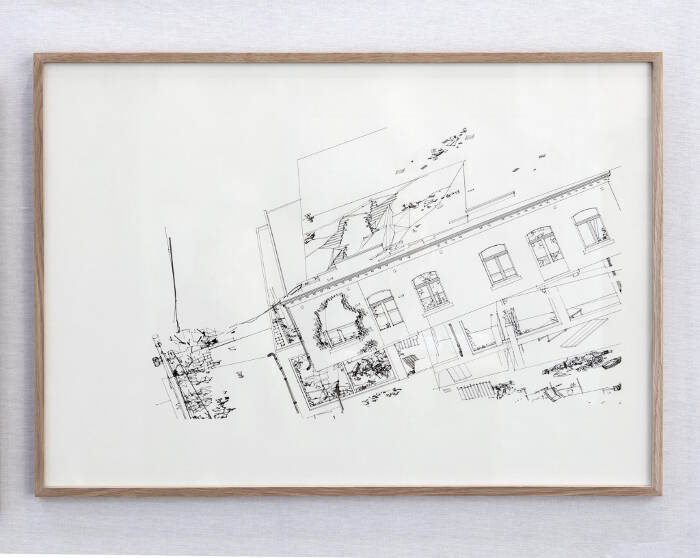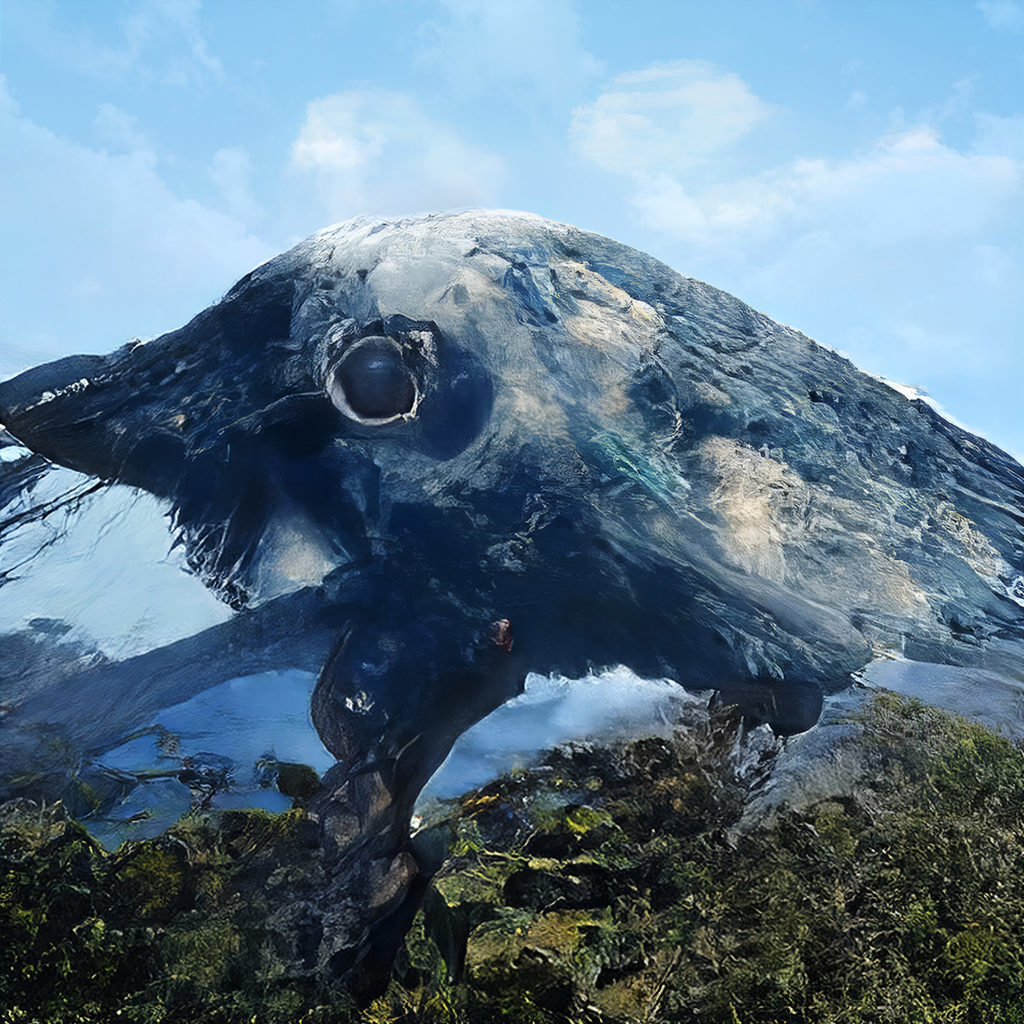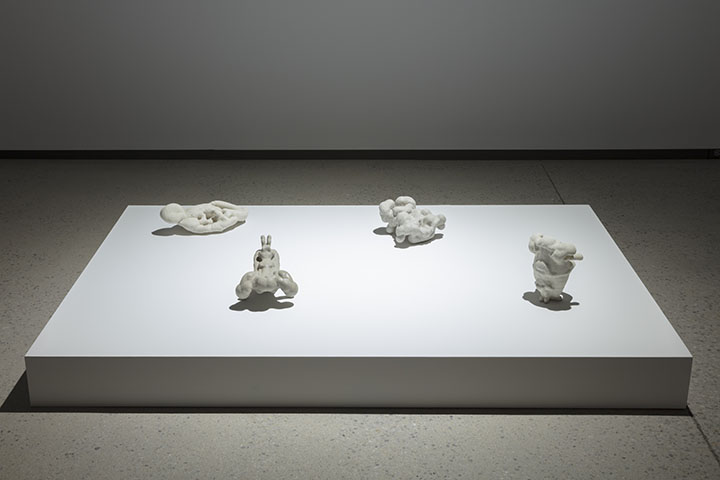Toutes les époques (ou comment exposer l’extinction)

Si le discours médiatique sur l’IA s’est concentré sur la promesse et l’inextricable crainte d’une disruption, le présent étant dans ce cadre purement et simplement balayé par le futur, l’évolution des réseaux artificiels de neurones semble ouvrir la possibilité d’un autre discours et d’une autre temporalité où c’est le passé qui vient comme suspendre le présent.
En effet, les réseaux artificiels de neurones consistent en une induction statistique par laquelle, en fournissant à un logiciel de grandes quantités d’informations, il apprend à produire des résultats ressemblants. Le degré de cette ressemblance est déterminé, au sein du logiciel puis de l’être humain, par la relation entre l’induction qui homogénéise et le bruit qui diversifie jusqu’au point où le résultat peut devenir illisible.
Or le propre de ces stocks d’informations c’est d’être une figure du passé. Stocker de l’information c’est conserver ce qui a eu lieu. La trace vient donc alimenter ce qui peut advenir, une nouvelle donnée qui n’est pas seulement la répétition à l’identique de ce qui a eu lieu, mais qui entretient une ressemblance avec lui. Dans cette ressemblance, il y a une dialectique entre la répétition et la différence, équilibre ou déséquilibre qui va de l’identique mimétique au bruit. Le logiciel apprend à poursuivre une base de données, à continuer une série au-delà des limites de ce qui s’est passé tout en semblant rester dans la même famille.

Ceci advient au moment même où par ailleurs les conditions matérielles de l’Histoire semblent pouvoir s’arrêter parce que l’extinction de l’espèce humaine apparaît de plus en plus probable. En l’absence de témoin, ce que nous avons nommé l’Histoire cesserait dans sa constitution même. Or que le passé des données massives viennent alimenter les possibles d’une série qui se poursuit constitue un écho de cette possibilité extinctive.
Sous une forme abrégée, j’avais désigné cette relation entre les données massives, les réseaux artificiels de neurones et l’extinction, comme le destin égyptien de notre civilisation. Tout se passe comme si nous constituions par anticipation un monument à l’espèce disparue que nous allons devenir, produisant par là même un témoin non-humain mais technique de ce passé que nous sommes à nous-mêmes. Ce récit n’est pas celui du futur mais du présent.
L’extension de la finitude individuelle à la finitude de l’espèce ouvre et ferme dans le même mouvement l’absolu en tant que ce qui est délié : la déliaison qui excéderait l’onto-théologie consisterait en ceci que nous allons disparaître, jusqu’au dernier et qu’ainsi nous n’avons d’autre accès par anticipation au futur que la biffure.

En ce sens, l’automatisation de la ressemblance, qui est une des possibilités des réseaux artificiels de neurones, est non seulement le précieux symptôme de notre époque mais vient modifier jusqu’à l’historicité elle-même, c’est-à-dire la manière de constituer l’Histoire. Et on ne peut que se mettre à rêver à la relation entre cette dynamique de la ressemblance automatique et l’éternel retour nietzschéen : non pas que le même revienne mais le vouloir du même qui peut être entendu comme le projet de l’imagination artificielle en son entier. On pense aussi à Derrida et au lien entre l’archive et l’avenir.
Par l’imagination artificielle, nous comprenons d’une part que nous ne possédons pas des facultés (imagination, intuition, entendement, raison) comme notre propriété, mais qu’elles sont toujours le fruit d’une attribution relationnelle, dans la subjectivité comme dans l’intersubjectivité. C’est pourquoi il n’y a pas de transparence à soi des facultés, il n’y a pas de clarté de la conscience. Nous entendons également la solidarité profonde et structurelle entre la matérialité de l’extinction et les développements technologiques qui ne sont, eux aussi, qu’une formation matérielle (et il n’y a aucune raison de considérer la volonté humaine qui présiderait à leur constitution comme étant hors de cette matérialité).

Derrière le discours volontariste de l’innovation qui affiche ses objectifs comme autant d’impossibilités, se cache une pulsion disnovative : le futur ne bouscule pas nos habitudes, c’est bien la répétition du passé qui pourrait produire l’image d’un avenir disloquant la distinction entre la répétition et la différence.
Cette disnovation qui est la réalité de l’innovation, a pris la forme dans mon travail artistique d’une recherche sur :

– La dislocation (http://chatonsky.net/category/corpus/dislocation), c’est-à-dire la relation entre notre culture et les ruines.

– L’hyperproduction (http://chatonsky.net/category/corpus/hyperproduction), c’est-à-dire de la capacité des machines à produire plus que nous ne pouvons percevoir produisant par là même le paradoxe d’une production humaine des techniques qui outrepasse les capacités de son « auteur » et qui semblerait autonome.

– L’imagination artificielle (http://chatonsky.net/category/corpus/ami), c’est-à-dire de l’antériorité de l’image sur le concept dans le jeu de synthèse et d’unification des facultés humaines et des dispositifs technologiques, ceci ayant comme conséquence d’appliquer une boucle relationnelle à la question transcendantale.

– L’extinction (http://chatonsky.net/category/corpus/extinction), c’est-à-dire l’avenir entendu comme la possibilité de notre disparition collective supprimant la capacité même à témoigner de la disparition.
Cette quadruple approche a eu comme conséquence, à partir de 2010, de déployer une méthodologie d’exposition : placer les visiteurs dans la posture spéculative de leur propre extinction, en observant des machines semblant fonctionner toutes seules et étant comme les seules traces de notre disparition, afin de revenir plus intensément au présent. Par là même on tente de développer une esthétique de la séparation : s’il est possible de donner à percevoir notre absence c’est d’une part que l’imagination est le premier pouvoir de synthèse des facultés et c’est d’autre part que la perception est toujours en tension avec le pouvoir de déliaison de l’absolu. Ce dispositif spéculatif n’est pas sans rapport avec le sublime mais alors qu’habituellement celui-ci nous place devant un objet extérieur qui n’est pas proportionné à nos facultés, avec l’extinction c’est nous-mêmes qui somme en défaut : nous manquons à l’appel et nous sommes en capacité d’imaginer cette absence. Le dehors reste impassible, il n’est ni grand ni petit, il perd toute échelle parce que nous spéculons sur un monde sans nous. Le précaire équilibre transcendantal est alors déjoué non du fait d’un changement externe mais d’un suppression interne : nous ne serons plus, non pas individuellement mais comme espèce, laissant impensé cette disparition de sorte que nous imaginons l’absence à deux niveaux. Le premier est la présence à soi, la seconde la possibilité de la trace mémorielle qui permet la temporalisation.
–
If the media discourse on AI has focused on the promise and the inextricable fear of disruption, the present being in this framework purely and simply swept away by the future, the evolution of artificial neural networks seems to open up the possibility of another discourse and another temporality where it is the past that comes as if suspending the present.
Indeed, artificial neural networks consist of a statistical induction by which, by providing a software program with large amounts of information, it learns to produce similar results. The degree of this resemblance is determined, within the software and then in the human being, by the relationship between the induction that homogenizes and the noise that diversifies to the point where the result may become unreadable.
Now the characteristic of these stocks of information is to be a figure from the past. To store information is to preserve what has taken place. The trace thus comes to feed what can happen, a new data which is not only the identical repetition of what has taken place, but which maintains a resemblance with it. In this resemblance, there is a dialectic between repetition and difference, balance or imbalance that goes from identical mimetic to noise. The software learns to chase a database, to continue a series beyond the limits of what has happened while seeming to remain in the same family.
This happens at the very moment when, on the other hand, the material conditions of History seem to be able to stop because the extinction of the human species seems more and more probable. In the absence of a witness, what we have called History would cease in its very constitution. Now that the past massive data come to feed the possibilities of a series that continues constitutes an echo of this extinctive possibility.
In an abbreviated form, I had designated this relationship between massive data, artificial neural networks and extinction as the Egyptian destiny of our civilization. Everything happens as if we were anticipating a monument to the extinct species that we are going to become, thereby producing a non-human but technical witness to the past that we are to ourselves. This is not a story of the future but of the present.
The extension of individual finitude to the finitude of the species opens and closes in the same movement the absolute as that which is unbound: the unbounding that would exceed onto-theology would consist in the fact that we are going to disappear, to the very last and that thus we have no other access by anticipation to the future than biffure.
In this sense, the automation of resemblance, which is one of the possibilities of artificial neural networks, is not only the precious symptom of our times, but also modifies even historicity itself, that is to say, the way in which History is constituted. And we can only dream of the relationship between this dynamic of automatic resemblance and the eternal Nietzschean return: not that the same returns but the will of the same that can be understood as the project of the artificial imagination in its entirety. We also think of Derrida and the link between the archive and the future.
Through artificial imagination, we understand on the one hand that we do not possess faculties (imagination, intuition, understanding, reason) as our property, but that they are always the fruit of a relational attribution, in subjectivity as well as in intersubjectivity. This is why there is no transparency of faculties to oneself, there is no clarity of consciousness. We also mean the deep and structural solidarity between the materiality of extinction and technological developments, which are also only a material formation (and there is no reason to consider the human will that would preside over their constitution as being outside this materiality).
Behind the voluntarist discourse of innovation, which displays its objectives as so many impossibilities, lies a disnovative impulse: the future does not upset our habits, it is indeed the repetition of the past that could produce the image of a future dislocating the distinction between repetition and difference.
This disnovation, which is the reality of innovation, has taken the form in my artistic work of a research on :
- Dislocation (http://chatonsky.net/category/corpus/dislocation), that is, the relationship between our culture and the ruins.
- Hyperproduction (http://chatonsky.net/category/corpus/hyperproduction), that is to say the capacity of machines to produce more than we can perceive, thereby producing the paradox of a human production of techniques that exceeds the capacities of its “author” and which would seem autonomous.
- Artificial imagination (http://chatonsky.net/category/corpus/ami), i.e. the anteriority of the image over the concept in the game of synthesis and unification of human faculties and technological devices, which has the consequence of applying a relational loop to the transcendental question.
- Extinction (http://chatonsky.net/category/corpus/extinction), i.e., the future understood as the possibility of our collective disappearance suppressing the very capacity to bear witness to disappearance.
This quadruple approach has resulted, starting in 2010, in the deployment of an exhibition methodology: placing visitors in the speculative posture of their own extinction, observing machines that seem to work on their own and are like the only traces of our disappearance, in order to return more intensely to the present. In this way we try to develop an aesthetics of separation: if it is possible to give to perceive our absence it is on the one hand that imagination is the first power of synthesis of the faculties and on the other hand that perception is always in tension with the power of unbinding the absolute. This speculative device is not unrelated to the sublime, but while the latter usually places us in front of an external object that is not in proportion to our faculties, with extinction it is ourselves that are at fault: we are missing and we are in a position to imagine this absence. The outside remains impassive, it is neither big nor small, it loses all scale because we speculate on a world without us. The precarious transcendental equilibrium is then thwarted not because of an external change but because of an internal suppression: we will no longer be, not individually but as a species, leaving this disappearance unimagined so that we imagine absence on two levels. The first is the presence to oneself, the second is the possibility of the memory trace that allows temporalization.
